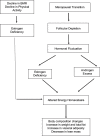Weight Management Module for Perimenopausal Women: A Practical Guide for Gynecologists
- PMID: 31942151
- PMCID: PMC6947726
- DOI: 10.4103/jmh.JMH_155_19
Weight Management Module for Perimenopausal Women: A Practical Guide for Gynecologists
Abstract
Menopause has been identified as a high-risk stage for weight gain in a woman's lifecycle. Menopause-related weight gain is a consequence of low circulating estrogen levels due to progressive loss of ovarian function. Moreover, the changes in the hormonal milieu, chronological aging, decline in physical activity coupled with westernized dietary pattern, and recurrent emotional eating episodes associated with psychological distress also contribute to the increase in total body fat and waist circumference. Higher waist circumference is an independent risk factor for cardiovascular and metabolic disease in menopausal women. These obesity-related cardiometabolic risk factors and menopausal symptoms can be effectively managed by achieving clinically significant weight loss through lifestyle modification. Behavioral lifestyle intervention uses behavioral techniques for counseling corrective dietary and physical activity practices in achieving sustainable weight loss outcomes. Majority of menopausal women seek this counseling from gynecologist, especially in primary care settings due to nonavailability of multidisciplinary teams. Thus, the aim of the review is to understand the menopause-obesity link, associated risk factors, and its health-related burden in perimenopausal women to devise a practical women-centric weight management module based on lifestyle modification techniques to address the burden of menopausal obesity in regular gynecological practice.
Keywords: Diet; lifestyle management; menopause; obesity; physical activity; weight loss.
Copyright: © 2019 Journal of Mid-life Health.
Conflict of interest statement
There are no conflicts of interest.
Figures
References
-
- Zhu D, Chung HF, Pandeya N, Dobson AJ, Kuh D, Crawford SL, et al. Body mass index and age at natural menopause: An international pooled analysis of 11 prospective studies. Eur J Epidemiol. 2018;33:699–710. - PubMed
-
- National Family Health Survey NFHS-4, 2015-2016. Mumbai, India: International Institute for Population Sciences; 2017. International Institute for Population Sciences-IIPS/India and ICF.
-
- Population Projections for India and States 2001-2026. New Delhi: Government of India; 2006. Office of the Registrar General and Census Commissioner.


